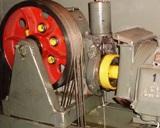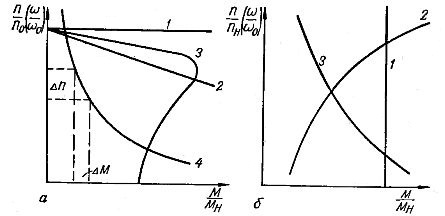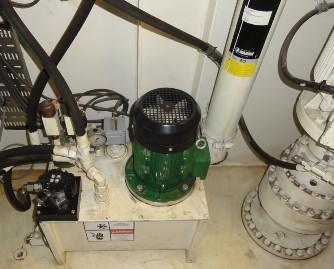Mechanical characteristics of electric drives
 The choice of electric drive is determined by the requirements of the work machine. The electric drive must ensure that the working machine performs the specified technology in all possible modes: starting, receiving and discharging the load, stopping, changing the speed, constant load. The nature of these modes is mainly determined by the mechanical properties of the engine and the working machine... One of the main criteria for evaluating the mechanical properties of both the engine and the working machine is their mechanical characteristics.
The choice of electric drive is determined by the requirements of the work machine. The electric drive must ensure that the working machine performs the specified technology in all possible modes: starting, receiving and discharging the load, stopping, changing the speed, constant load. The nature of these modes is mainly determined by the mechanical properties of the engine and the working machine... One of the main criteria for evaluating the mechanical properties of both the engine and the working machine is their mechanical characteristics.
Mechanical characteristics of electric motors
The mechanical characteristic of the electric motor is the dependence of the speed of rotation of the shaft on the torque developed by the motor ω=φ(Md) or n = e(Md) where ω — angular speed of rotation of the shaft, rad / sec, n — speed of shaft rotation, rpm
The mechanical characteristic of the motor is called the natural dependence n = f (M) is obtained with the nominal parameters of the power network, the normal connection scheme and without additional resistances in the electrical circuit.
If there are additional resistances or the motor is fed from a network with a voltage or frequency other than the nominal one, the mechanical characteristics of the motor will be called artificial... Obviously, the motor has an infinite number of artificial characteristics and only one natural one.
Most electric motors, under load, decrease in speed as torque increases. The characteristic in this case is called falling... The degree of change in engine speed with a change in torque is estimated by the so-called stiffness of mechanical characteristics, which is determined by the ratio α = ΔM / Δω or α = ΔM / Δн

Rice. 1. Different types of mechanical characteristics: a — electric motors, b — production machines.
The values of the change in moment and the rate of fall in the determination of stiffness are usually taken in relative units. This makes it possible to compare the characteristics of different types of engines.
Depending on the degree of rigidity, all mechanical characteristics of engines are divided into the following groups.
1. Absolute heavy performance with stiffness value α = ∞… Synchronous motors have such mechanical characteristics (curve 1, Fig. 1, a) with a strictly constant speed of rotation.
2. Solid characteristics with a relatively small drop in speed with increasing torque and α = 40 — 10.This group includes the natural characteristics of DC motors with independent excitation (curve 2) and the characteristics of induction motors in the linear section (curve 3).
3. Soft mechanical characteristics with a large relative drop in speed with increasing torque and with stiffness up to α = 10. Such characteristics have DC motors with series excitation (curve 4), independently excited motors with high armature resistance and asynchronous motors with additional resistances in the rotor circuit.
During the operation of the electric drive, in order to overcome the resistance of the working machine, the motor must develop a certain moment. Therefore, when choosing an engine, it is first necessary to identify the correspondence of the characteristics of the engine and the working machine.
Mechanical characteristics of working machines
The mechanical characteristic of the working machine is the dependence of the moment of static resistance of the machine on the speed of rotation of the drive shaft. For the convenience of joint construction, this dependence is usually expressed in the same way as the motor characteristic, in the form ω=φ(Ms -Ms) or n =e(Miss).
Moment of static resistance Ms, or static moment for short, is the moment of resistance created by the machine on the drive shaft in a static (stationary) mode when the speed does not change.
The mechanical characteristics of the machine can be obtained empirically or by calculation if the distribution of static forces or moments on the elements of the kinematic scheme is known.The static moments of the machines can depend not only on the speed, but also on other quantities, therefore, in the practical calculations of the electric drives, it is necessary to consider each case separately.
The static moments of various working machines are divided into groups according to the nature of their speed dependence (mechanical characteristics). The most common in practice are the following.
1. The static moment depends little or practically does not depend on the speed (curve 1, Fig. 2, b). Such characteristics have lifting mechanisms, cranes, winches, hoists, as well as belt conveyors under constant load.
2. The static moment of the machine increases in proportion to the square of the speed (curve 2). This characteristic, characteristic of axial fans, is called the characteristic of the fan and analytically presented in the form of the formula: Mc = Mo + kn2, where Mo is the initial static moment, most often due to frictional forces, which usually do not depend on the speed, k is the experimental coefficient. In addition to fans, centrifugal and vortex pumps, separators, centrifuges, propellers, turbochargers, and rotating drum idlers have fan characteristics.
3. The static moment decreases with increasing speed (curve 3). This group includes the characteristics of some conveyor mechanisms and some metal cutting machines.
4. The static moment varies with the speed ambiguously, with a sharp transition due to the peculiarities of the technological process. The characteristics of this group have machines that work with frequent large overloads, which sometimes lead to a complete stop.For example, scooping mechanism for a single-bucket excavator, scraper conveyor, working under blocking of the transported mass, crushers and other machines.
In addition to those listed, in practice there are other types of mechanical characteristics of machines, for example, piston pumps and compressors, whose static moments depend on the path.

